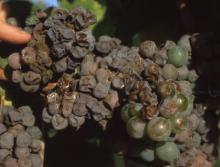By M. Moyer
See:
Grape (Vitis spp.) - Botrytis Bunch Rot
Cause Sour rot is caused by a succession of events starting with berry wounding, then ethanol production by Saccharomyces yeasts, then acetic acid production from ethanol by bacteria, followed by fruit fly activity. The "sour" or vinegar smell is typically associated with the invasion of the bacteria Acetobacter and Gluconobacter. The vinegar smell is due to both gluconic acid as well as acetic acid. The yeasts or bacteria alone cannot by themselves cause sour rot. The specific activity of fruit flies is not known. If fruit is initially damaged as a result of excessive rain (as in the fall of 2013), excessive wind and/or other diseases or insect pests, many secondary invasions by fungal and bacterial microorganisms can occur. Sour rot is of concern when rain occurs after berries are at or above 15 Brix and temperatures are in the 60's. Sour rot typically does not spread from cluster to cluster, but can result in whole cluster loss.
Sour rots can be a significant problem regardless of harvest weather conditions. They are associated with varieties with compact clusters and varieties that are aromatic (and thus, attract insects). Conditions that favor development of grapevine powdery mildew or Botrytis bunch rot can also favor sour rot development.
Symptoms Sour rot is best described as a "wet rot" in ripening grape clusters. Typical symptoms include a brown discoloration of the fruit and wet or oozing berries, coupled with the smell of vinegar and the presence of fruit flies. Sour rot is often confused with (and in many cases associated with) the early stages of Botrytis bunch rot, but can be distinguished by the associated "sour" smell. As a general distinction, Botrytis bunch rot is a dry (fuzzy) rot of ripening fruit, whereas sour rot is considered a wet rot.
Cultural control Once sour rot begins in a vineyard, it cannot be controlled. Therefore, the primary tactic in managing sour rot is prevention of fruit damage as a result of other diseases, insect pests, and birds.
- Leaf removal as is done for bunch rot management will also be helpful for sour rot. Remove leaves adjacent to clusters at fruit set (BBCH 71) to pea-sized (BBCH 75) stage, which also aids in spray penetration and coverage.
- Dropping affected clusters preharvest may help prevent inadvertent picking of diseased fruit.
- If sour rot symptoms are severe, pick as early as possible to reduce the amount of spoiled fruit.
Chemical control While there are no real effective chemical measures specifically designed for the management of sour rot, in-season programs that provide effective control of powdery mildew and Botrytis bunch rot may reduce the risk of developing sour rot in a vineyard. Methods that target both microbes and fruit flies are necessary after berries are 15°Brix. See the PNW Insect Management Handbook for details on fruit fly management. The following specifically mention sour rot.
Combination Fungicides Must be used in conjunction with other methods.
- Luna Experience at 8 to 8.6 fl oz/A. Do not use if already used for powdery mildew control. Do not use on 'Concord' or with-in 14 days of harvest. Group 3 + 7 fungicide. 12-hr to 5-day reentry depending on activity.
- Miravis Prime at 9.2 to 13.4 fl oz/A. Do not use for sour rot control if already used for powdery mildew control. Do not use within 14 days of harvest. Group 7 + 12 fungicide. 12-hr reentry.
- Regev at 4 to 8.5 fl oz/A. Do not apply within 2 days of harvest. Group 3 + BM01 fungicides. 12-hr reentry.
- Switch 62.5 WG at 11 to 14 oz/A. Do not use an adjuvant or within 7 days of harvest. Good control. Group 9 + 12 fungicide. 12-hr reentry.
Biological control Must be used in conjunction with other methods.
- DoubleNickel 55 (Bacillus amyloliquefaciens strain D747) at 0.25 to 3 lb/A. Unknown efficacy. Group BM02 fungicide. 4-hr reentry. O
- Serenade OPTI (Bacillus subtilis strain QST 713) at 14 to 20 oz /A. Active ingredient is a small protein. May be applied up to and including day of harvest. 4-hr reentry. O
Note Some registered products offer only suppression of this disease and thus are not recommended for use. These products include Fracture and Kenja.
Reference Hall, M.E., Loeb, G.M., Cadle-Davidson, L., Evans, K.J. and Wilcox, W.F. 2018. Grape sour rot: A four-way interaction involving the host, yeast, acetic acid bacteria, and insects. Phytopathology 108:1429-1442.
Huber, C. 2016. Etiology and Management of Grape Sour Rot. PhD thesis, Dept of Biological Sciences, Brock University, Ontario.

